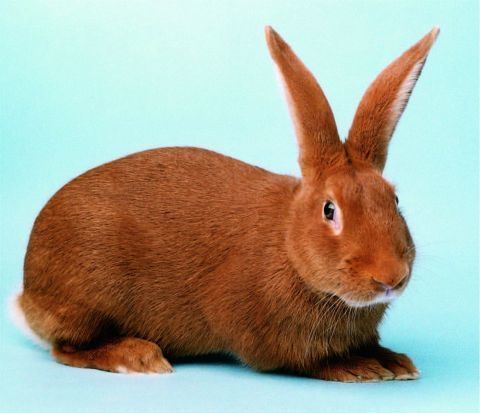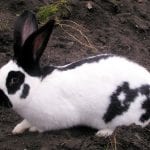Scientific Facts
| Common Name | Czech Red rabbit |
| Body Shape | Compact |
| Size | 10.5 cm / Medium |
| Life Span | 7 – 10 years |
| Country of Origin | New Zealand |
Rabbit is a Czech national strain quite comparable to Saxon Gold and Thriantou. Theodor Svoboda bred the Czech Red from Modřany employing stalls of a reddish color, New Zealand tan red and red. In 1951, they were first displayed in Prague. Their identification as a breed transpired in 1959 – two years before the identification of Saxon gold.
Physical Description
The Czech red rabbit can measure to any extent from 1.8-2.7 kgs once it is completely matured, and keeps a thick body frame. Generally, this rabbit breed must be plump, rounded, and smooth with rear legs that are likewise plump from all areas. It must have upright, chunky, short, and full stance on a short neck, thickly-coated ears.
Coat
Czech red rabbits have short, dense, average-length rollback wool, which is soft to the sense. It does not need any particular brushing but would profit from being brushed once every couple weeks with a slicker graze. During the shedding period, Czech red rabbits must be brushed every week or as needed to eliminate messy fibers from the fur and maintain it in great shape. Beneath no conditions should any rabbit be scrubbed, as this creates a huge burden and may even prompt their end. Rather, solely spot-clean its fur with a wet fabric to eliminate any filth.
Colors
The ARBA affirms merely one color of Czech red rabbit, and that is its trademark blazing red on its whole body with no other frame impressing.
Habitat
Though they’re moderately small, rabbits demand quite a minimum of the area to spread out or bounce around. Most specialists suggest a dog playpen for the rabbit to name home, however, if you must to adopt an enclosure, getting it the biggest one you can acquire. Buying an enclosure or box no less than 48” long, 24” wide and 48” tall, gives enough area for a water and food bowls, toys, litter box, and for the rabbit to be on its feet or lay spread out. The box must have a firm foundation, and a cover, sheet, or cloth on the base of the box will prevent the rabbit from gliding and provide it a convenient surface to lie on.
Common Behavior
The Czech red rabbit is an exceptional breed for those desiring to seek out pet possession with a rabbit, as they are tender, loving animals who do not need much sustenance to have it satisfied. Its adaptable quality likewise presents them great pets for households with more youthful youngsters, as its size is little enough to be reasonable though not small enough to be remarkably weak or easy to unintentionally injure. The Czech red Rabbit also offers excellent pets for seniors, singles, and couples.
Rabbits are much more difficult to trash train than other mammals such as felines, canines, and birds, though it is conceivable with loads of perseverance, patience, and lots of treats. Numerous rabbit parents will hold 5 or 6 litter dispersed across their place so their pet rabbit can efficiently locate the litter box rather than take action wherever they gratify. With loads of rewards, time, and patience, your Czech red rabbit will surely be on their route to being litter raised!
Diet and Feeding Habits
Provide Czech Red Rabbits grass to help in digestion and lessen the danger of fur-balls blocking the digestive tract. Their nutrition must comprise of 70% of grass and make certain they have clean water regularly. They can obtain root legumes like parsnips and carrots occasionally. Supply them rabbit grains for their everyday expenditure. Alfalfa gives the necessary caloric content needed for infant bunnies growth. Once rabbits attain seven months of age, slowly shift them over to orchard grass, timothy hay, or oat hay.
Refrain providing them yard cuttings, because the grass is frequently sprinkled with insecticides, pesticides, and fertilizer, and other substances rabbits should not be consuming. You can present it rabbit-safe bite playthings or wooden bars to champ on. Even if the rabbit is held for meat, supply it anything harmless to bite on; their front teeth develop up to 12.7 cm (five inches) a year.
How to Breed
As they grow toward adolescence, approximately 3 months of age, both females and males begin mounting each other. Bucklings begin arguing. Some of this activity is similar to building a supremacy system, but a whole bunch of it is expressing developing sexuality. It is most beneficial if the rabbits aren’t permitted to reproduce until they are a few months older and more physically evolved.
Unlike canines and felines, rabbits don’t work in and out of the heat. Preferably, they are urged ovulators, which indicate that the action itself prompts the doe to ovulate within hours of coupling. But that doesn’t imply she possesses no period. A doe will feel a hormonal cycle of nearly 18 days: 12 to 14 days of enthusiasm and 4 days of declining to mate.
Here’s how it goes: The period begins with the female holding five to ten (or more) eggs that are developed and available for breeding. These eggs are enclosed in fluid-packed, cell-lined follicles that generate estrogen for up to 14 days, anticipating and set for the external stimulus of coupling. If coupling happens, the follicles burst inside 10 hours, delivering the eggs, which are then fertilized and embed themselves in the uterus.
If no coupling transpires, the follicles and eggs decay, and the ovaries start preparing a different set of eggs. The female will decline any proposals of the male until the latest collection of eggs has culminated, and the follicles start drawing out the estrogen, which uses nearly 4 days.
Pet Care
Rabbits are neat by character and won’t make their business loosely all-around their cage. Rather, they’ll select one edge of the cage as their lavatory and constantly move there. Once your rabbit has delivered its decision, set the litter crate or vessel. Experts suggest stuffing the crate with a sheet of paper and then loading it to the roof with grass. This produces a “miniature garden” for the rabbit, where it can rest, feed, and works its business while the grass engrosses the odor.
Rabbits are whimsical, dynamic, and inquisitive, and they require an excellent assortment of playthings to have them engaged (and out of stress). Toys are likewise vital to a rabbit’s mental fitness and present a chance for you to mingle with your bunny.
Because of the rabbit’s short hair, it is not at danger for digestive problems such as woodblock, though it is yet vulnerable to obstacles such as flystrike, ear mites, and overgrown teeth. Rabbit partners must examine their rabbit’s ears every 2-3 weeks for ticks, and if your rabbit’s intake does not comprise largely of grass, it may develop overgrown teeth. This will change if/how much it consumes, as its continually developing teeth can stretch into its muzzles and faces and be severe. This can be remedied with a prompt visit to your local doctor at first, and then shift to nutrition that is higher in the grass, as it generally pounds down your rabbit’s teeth.
Availability
Pets are extremely prevalent in the Czech Republic. Seek for a rabbit at your local pet store or feed shop. Even if they possess no rabbits at the moment, they might have contact with a reliable rabbit breeder in your area.
The ARBA has an ARBA Breeders recording, which carries a comprehensive figure of member breeders, including the state where the breeder resides, contact data, and the breeds each breeder supports. Or employ Google or different research engines to explore for the species of rabbit you’re seeking for (enter your place in your search course), or work Craigslist, for instance.

FAQs
What are the five weight categories of rabbits?
The rabbit body variety breed divisions comprise; Semi-Arch Rabbit Breeds, Full-Arch Rabbit Breeds, Cylindrical Rabbit Breeds, Compact Rabbit Breeds, and Commercial Rabbit Breeds.
Do rabbits make good indoor pets?
Rabbits make excellent pets. In general, rabbits need a suitable home, training, socialization, and nutrition for healthy well-being.
Can rabbits be free in the house?
Free-roaming bunnies (with boundaries): An undisciplined rabbit requires guidance when you’re not there to watch him.
Will rabbits sleep with you?
Rabbits are deemed crepuscular animals; that is, they are most productive at sunrise and sunset. Your rabbit will not match your normal sleep swing.


